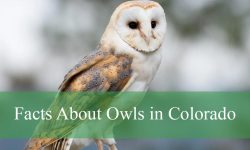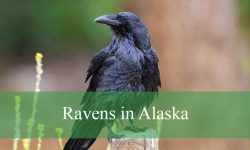Have you ever wondered which birds are the most common in Missouri? Whether you’re a beginner birdwatcher or just curious, Missouri offers a rich variety of bird species to discover.
From colorful songbirds to majestic raptors, this guide covers 44 common birds you’re likely to see across the state. With pictures and identification tips, you’ll learn how to spot and recognize these feathered friends easily.
Most Common Birds Found in Missouri
Eastern Bluebird
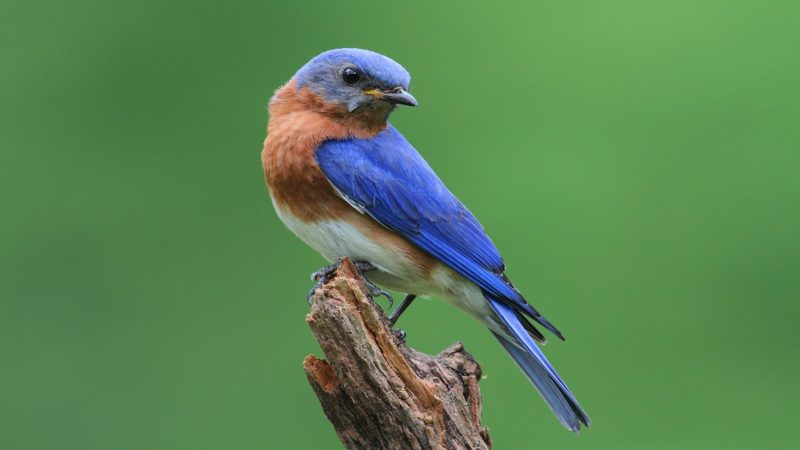
The Eastern Bluebird is a small thrush known for its vibrant blue upperparts and rusty red chest. Adults measure about 6.3 to 8.3 inches in length, with a wingspan of 9.8 to 12.6 inches. The males display brighter and more vivid blue feathers, while females have softer blue-gray tones. Their slender bodies and short, straight bills help them forage efficiently in open grassy areas and woodlands.
The song of the Eastern Bluebird is a soft, melodious warble often described as “tru-lu-lu” or “cheerful, sweet whistles.” They primarily feed on insects and berries, hunting by perching low and swooping down to catch prey on the ground. These birds are territorial during breeding season and are known to use nest boxes, making them favorites among bird watchers and conservationists.
In Missouri, Eastern Bluebirds are common residents and migratory visitors, favoring open fields, orchards, and edges of forests. Their populations benefit from nest box programs because they require cavities for nesting but do not excavate their own. The bluebird’s bright colors and charming song make it one of Missouri’s most beloved birds.
American Robin

The American Robin is a medium-sized songbird widely recognized by its warm orange-red breast and grayish-brown back. Adult robins typically measure about 9 to 11 inches in length with a wingspan ranging from 12 to 16 inches. Their bright yellow beak and white eye ring are distinctive features that make identification straightforward. In Missouri, robins are one of the most common birds you’ll see in gardens, parks, and wooded areas, especially during spring and summer.
Robins are well known for their melodious and cheerful song, which consists of a series of clear whistles that often start soft and build in intensity. Their call can be described as a “cheerily, cheer up, cheer up, cheerily, cheer up.” These birds are active foragers, frequently hopping across lawns to hunt for earthworms, insects, and berries. They often display an upright posture and a confident stance when perched on trees or wires.
In Missouri, American Robins are year-round residents but tend to be more visible during the warmer months when breeding activity peaks. They prefer open woodlands, suburban neighborhoods, and farmland edges where there are plenty of trees and shrubs for nesting. During colder months, some may migrate southward, but many remain, taking advantage of urban habitats where food is available.
Northern Cardinal
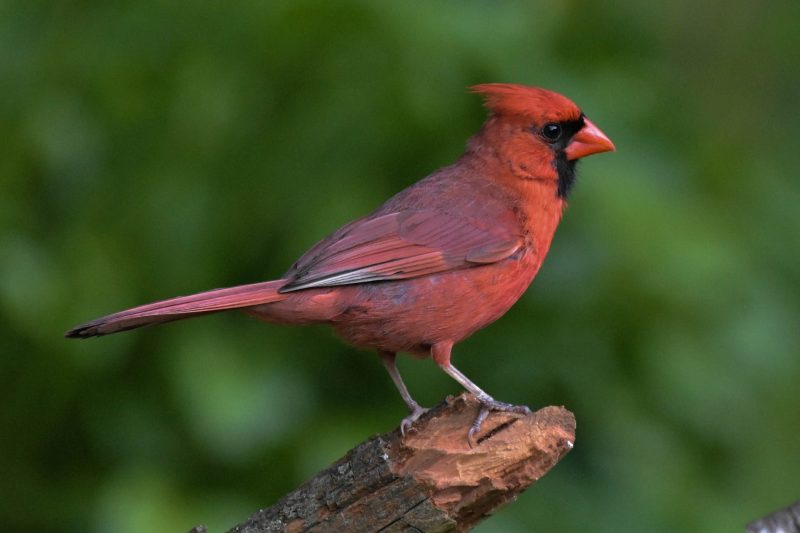
The Northern Cardinal is a strikingly beautiful bird with a vibrant red plumage in males, while females exhibit a more subdued tan with red tinges on the wings, tail, and crest. Cardinals measure approximately 8 to 9 inches in length, with a wingspan of around 10 to 12 inches. Their stout, cone-shaped beak is bright orange-red and perfectly suited for cracking seeds. This bird’s unmistakable crest and bold colors make it easy to spot in Missouri’s woodlands and backyards.
The song of the Northern Cardinal is a rich, clear whistle that can sound like “cheer, cheer, cheer” or a series of melodic whistles and chips. Both males and females sing, often engaging in duets, which is somewhat rare among songbirds. Cardinals are territorial and will fiercely defend their nesting sites. They feed mainly on seeds, fruits, and insects, often visiting feeders, making them a favorite among birdwatchers.
Throughout Missouri, Northern Cardinals are abundant year-round, adapting well to suburban and rural environments. They prefer dense shrubs and thickets for nesting, which provide cover and protection. Their vibrant coloration contrasts beautifully against the snowy winters and lush greenery, making them an iconic symbol of the state’s birdlife.
Blue Jay
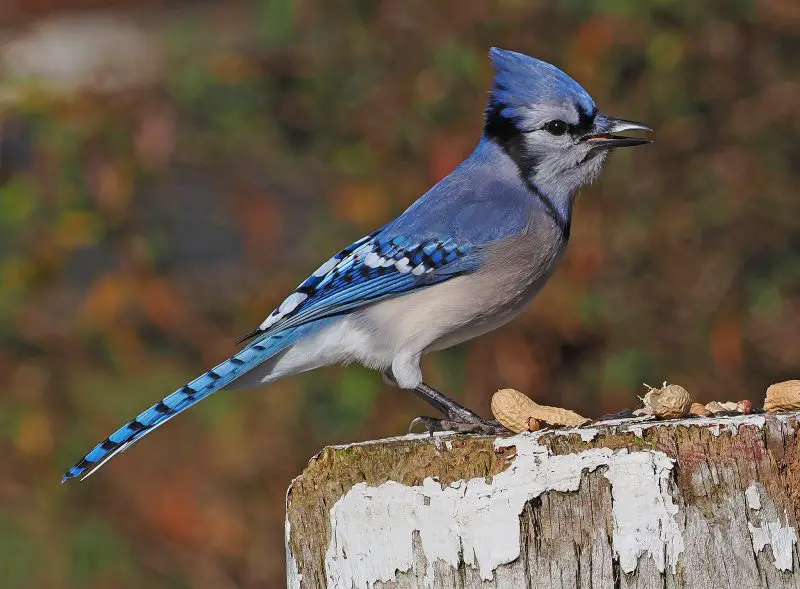
Blue Jays are medium-sized, striking birds known for their bright blue upperparts, white underparts, and distinct black markings around the neck and face. They measure about 9 to 12 inches long with a wingspan of 13 to 17 inches. The Blue Jay’s crest on top of its head can be raised or lowered depending on its mood, and their strong bill helps them crack nuts and seeds. In Missouri, Blue Jays are commonly found in forests, suburban areas, and parks.
Their vocal repertoire is large and varied, including harsh “jay” calls, musical whistles, and the ability to mimic the calls of hawks. The loud, raucous “jay jay” sound is the most familiar, often heard when they are alarmed or communicating within their social groups. Blue Jays are highly intelligent and social birds, often seen in family groups or small flocks. They display behaviors such as caching food for later and can be quite bold around humans.
Blue Jays inhabit deciduous and mixed forests throughout Missouri, as well as urban areas with trees. They are non-migratory residents but may move locally depending on food availability. These birds play an important ecological role by dispersing acorns and other seeds, helping maintain forest regeneration. Their adaptability and vocal nature make them one of Missouri’s most noticeable and fascinating birds.
Mourning Dove
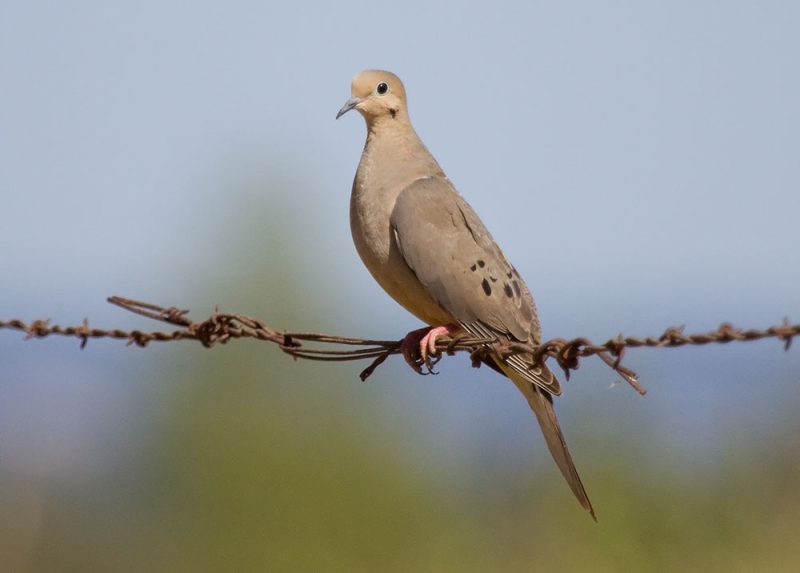
The Mourning Dove is a slender, graceful bird characterized by its soft gray and brown plumage with subtle black spots on the wings and a long, pointed tail edged in white. Adult doves typically measure around 9 to 13 inches in length, with a wingspan from 17 to 18 inches. Their small heads and large, dark eyes give them a gentle appearance. In Missouri, they are widespread and easily seen perched on telephone wires or foraging on the ground.
Their name comes from their mournful, drawn-out cooing call, which is a soft, haunting “coo-ah, coo, coo, coo.” This call is often heard during courtship or when maintaining territory. Mourning Doves are primarily seed eaters, feeding on grains, weed seeds, and small fruits. They tend to be calm and cautious birds but can take flight quickly when startled, revealing their distinctive pointed wings and fast, direct flight.
These birds thrive in a variety of habitats across Missouri, including open fields, farmlands, suburban yards, and forest edges. Mourning Doves are among the most abundant and widespread birds in the state, nesting on tree branches or sometimes on building ledges. They are mostly non-migratory but may move southward in colder winters to find food.
Red-tailed Hawk
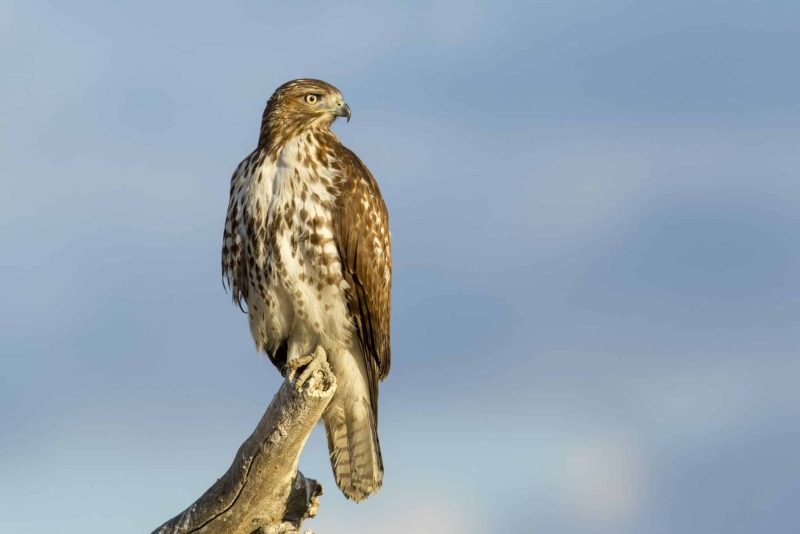
The Red-tailed Hawk is a large raptor easily identified by its reddish-brown tail, broad wings, and robust body. Adults typically measure 18 to 26 inches in length, with a wingspan ranging from 43 to 57 inches, making them one of the most impressive birds of prey in Missouri. Their plumage is variable but usually includes a pale underside with a dark band across the belly and a rusty red tail that becomes vivid in adults. Their sharp, hooked beak and strong talons make them efficient hunters.
This hawk’s vocalization is a loud, piercing scream often described as a “kee-eeeee-arr,” which is frequently used in movies to represent all hawks or eagles. Red-tailed Hawks hunt by soaring high and scanning the ground for prey such as small mammals, birds, and reptiles. They are known for their soaring flight patterns and may perch on poles or tall trees to ambush prey.
In Missouri, Red-tailed Hawks are common throughout the year and can be found in diverse habitats, including open fields, woodlands, and along highways. They prefer areas with open spaces for hunting combined with tall perches for nesting and roosting. Their adaptability to human-altered landscapes makes them a familiar sight in both rural and suburban settings across the state.
Downy Woodpecker
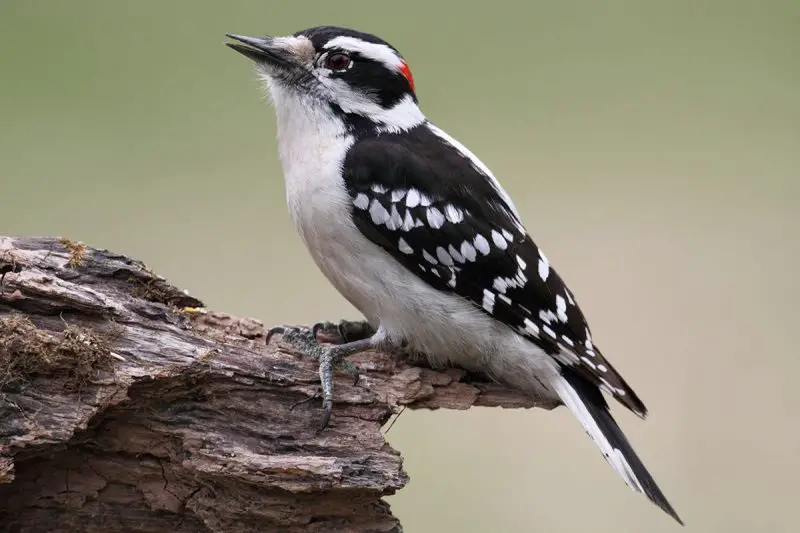
The Downy Woodpecker is a small, stocky bird with a distinctive black-and-white pattern. Adults measure about 5.5 to 6.7 inches in length, making them the smallest woodpecker in Missouri. Their back is primarily black with white spots, while their underside is white. Males have a small red patch on the back of the head, which females lack. Their short, chisel-like bill is well adapted for pecking into trees to find insects.
Their call is a sharp “pik” or “peek” sound, often accompanied by a rapid drumming on tree trunks or branches, used to communicate or establish territory. Downy Woodpeckers forage by hammering and probing into bark for insects like beetle larvae and ants, but they will also eat seeds and berries, especially in winter. They are agile birds that cling vertically to tree trunks, hopping quickly to search for food.
In Missouri, Downy Woodpeckers are widespread residents found in deciduous forests, woodlots, parks, and suburban areas. They prefer habitats with abundant dead wood for foraging and nesting. These woodpeckers nest in tree cavities they excavate themselves, often using the same nest sites year after year. Their adaptability to human environments makes them common visitors at backyard feeders.
Black-capped Chickadee

The Black-capped Chickadee is a small songbird easily recognized by its striking black cap and bib contrasted with white cheeks. Measuring about 4.7 to 5.9 inches in length with a wingspan of 7.5 to 10 inches, this bird has a soft gray back and wings with buff-colored sides. Its short bill and rounded body give it a distinctive silhouette. Chickadees are curious and active birds, often seen flitting through trees and shrubs.
Its vocalizations are varied, but the namesake “chick-a-dee-dee-dee” call is a common alert signal, with the number of “dee” notes indicating the level of threat nearby. Their song is a clear, whistled “fee-bee” or “hey, sweetie.” Black-capped Chickadees are omnivorous, feeding on insects, seeds, and berries. They store food in hidden spots for later consumption and exhibit acrobatic foraging behavior.
This species is a year-round resident throughout Missouri, frequenting mixed and deciduous forests, parks, and backyard feeders. They nest in tree cavities or nest boxes and are one of the few birds capable of lowering their body temperature to survive cold winters. Their friendly nature and distinctive calls make them a favorite among bird enthusiasts in the state.
American Goldfinch
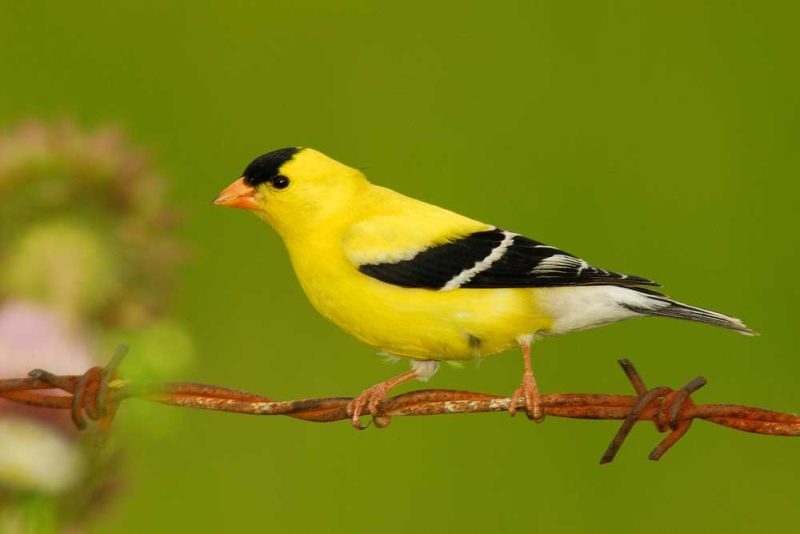
The American Goldfinch is a small, vibrant songbird renowned for its bright yellow plumage during the breeding season. Adult males are a brilliant yellow with black wings and a black forehead, while females and winter birds display duller olive tones. Measuring about 4.3 to 5.1 inches in length with a wingspan of 7.5 to 8.7 inches, the goldfinch has a conical beak well adapted for extracting seeds.
Its song is a cheerful, twittering series of musical notes and twitters, often described as a “per-chick-o-ree.” American Goldfinches are finicky feeders that specialize in seeds from thistles, sunflowers, and other plants. They are social birds, often seen in small flocks, especially outside the breeding season, and display lively, undulating flight patterns.
Throughout Missouri, American Goldfinches inhabit open fields, meadows, gardens, and woodland edges. They breed later in the summer compared to most songbirds to coincide with seed availability. Their striking yellow color and joyous song brighten the landscapes, and they are frequent visitors to backyard feeders offering nyjer or sunflower seeds.
House Sparrow
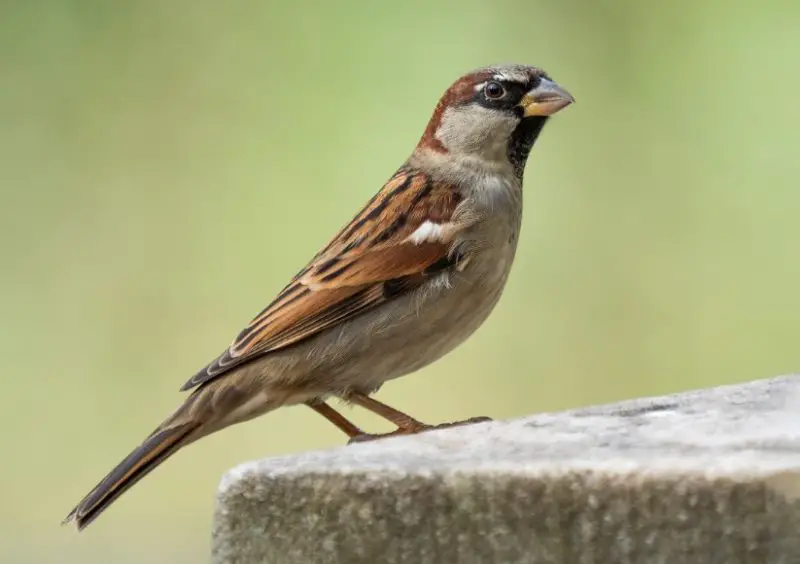
The House Sparrow is a small, stout bird measuring about 5.9 to 6.7 inches in length with a wingspan of 7.5 to 9.8 inches. Males have a distinctive gray crown, black bib, and chestnut brown markings on the wings, while females are a more uniform brown with streaks. This bird has a short, thick bill ideal for cracking seeds and thrives in close association with humans.
House Sparrows have a simple, repetitive chirping call, often described as “cheep” or “chirrup,” used for communication within flocks. Their behavior is social and highly adaptable; they scavenge a variety of foods from grains to scraps and can often be seen flocking around urban areas, farms, and feedlots. They are aggressive competitors and may displace native birds for nesting sites.
Introduced from Europe, House Sparrows are now common and widespread across Missouri’s towns, cities, and rural areas. They favor open habitats with nearby human structures for nesting, often using crevices in buildings or nest boxes. Their presence is a familiar part of the urban bird community but sometimes controversial due to their invasive nature.
European Starling
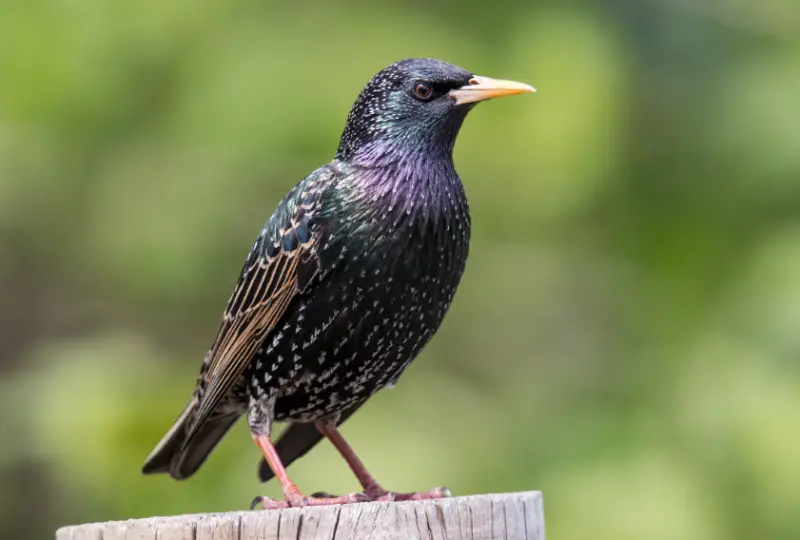
The European Starling is a medium-sized bird measuring about 7.9 to 9.1 inches in length with a wingspan between 12 and 16 inches. Its glossy black plumage has iridescent purple and green hues, especially noticeable in breeding adults. The bird’s sharp, pointed bill is yellow during the breeding season and darker in winter. Starlings are stocky with short tails and triangular wings.
Their vocalizations are diverse and complex, including whistles, clicks, and mimicry of other birds or sounds. European Starlings are highly social and often form large, noisy flocks known as murmurations, which create mesmerizing aerial displays. Their feeding habits are opportunistic, consuming insects, fruits, and human food scraps, and they often forage on lawns and agricultural fields.
In Missouri, European Starlings are year-round residents found in urban, suburban, and rural environments. Originally introduced from Europe, they have become one of the most abundant and widespread birds in the state. They nest in cavities, sometimes displacing native cavity-nesting species, and their adaptability has allowed them to thrive alongside human development.
Great Blue Heron
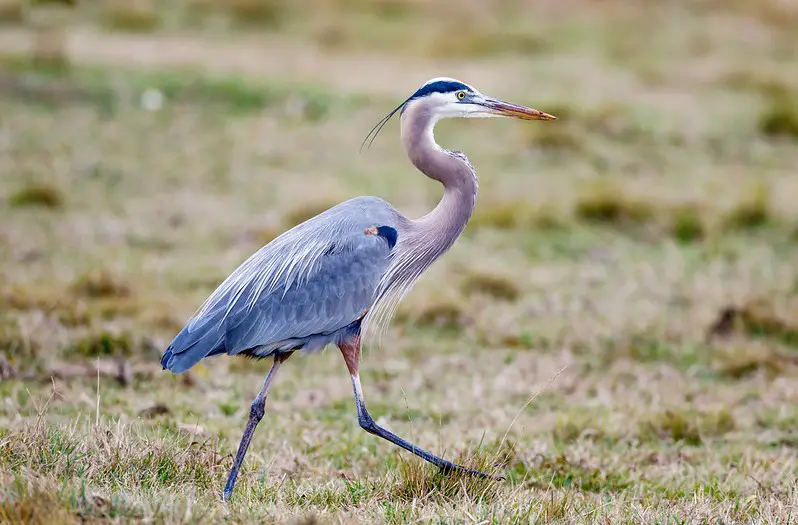
The Great Blue Heron is a large wading bird easily identified by its tall, slender stature and striking blue-gray plumage. Adults stand about 3.2 to 4.5 feet tall, with a wingspan of 5.5 to 6.6 feet, making them one of the largest birds in Missouri’s wetlands. Their long legs and neck, along with a sharp yellow bill, allow them to hunt efficiently in shallow water.
Their call is a low, harsh croaking sound that can be heard near their breeding colonies or when disturbed. Great Blue Herons hunt by standing still or slowly stalking prey such as fish, amphibians, and small mammals, striking quickly with their pointed bill. They often nest in large colonies called heronries, usually in tall trees near water.
Throughout Missouri, Great Blue Herons inhabit wetlands, riverbanks, ponds, and marshes. They are present year-round in much of the state and migrate southward from colder areas during winter. Their majestic appearance and silent, graceful hunting style make them an iconic species of Missouri’s aquatic habitats.
Song Sparrow
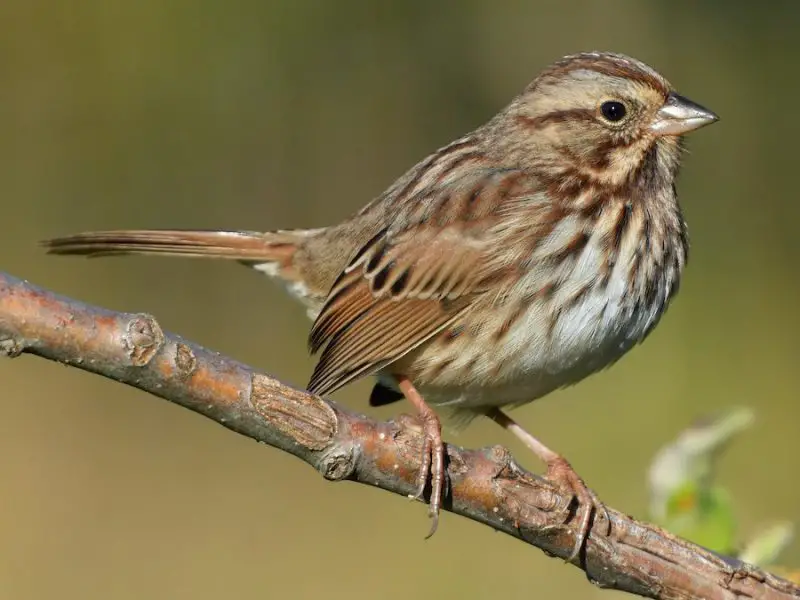
The Song Sparrow is a medium-sized sparrow known for its streaked brown and gray plumage and distinctive, heavily streaked breast with a central dark spot. Adults measure about 4.7 to 6.3 inches in length, with a wingspan of 7.5 to 9.8 inches. Their rounded heads and medium-length tails give them a compact appearance well suited to dense brush and thickets.
Their namesake song is a rich, melodious series of varied trills and whistles that can differ between regions. It is often described as a “sweet-sweet, I’m so sweet” phrase. Song Sparrows feed mostly on seeds and insects, foraging both on the ground and in low vegetation. They are territorial during breeding and are known for their adaptability to a wide range of habitats.
In Missouri, Song Sparrows are abundant residents found in marshes, brushy fields, forest edges, and suburban gardens. Their preference for dense cover makes them more often heard than seen, especially during the breeding season. This species’ beautiful song and widespread presence make it a familiar and cherished bird in Missouri’s diverse landscapes.
Carolina Wren
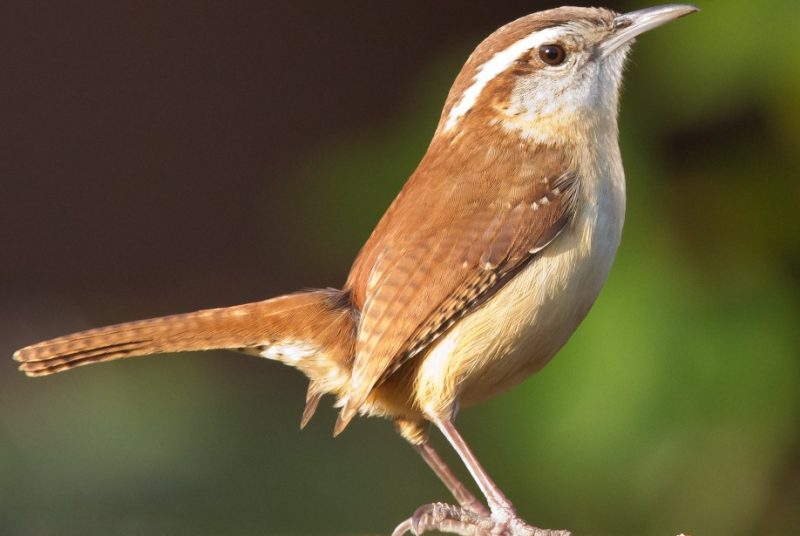
The Carolina Wren is a small, energetic bird with warm brown upperparts and a buffy-white underbelly. Measuring about 4.7 to 5.5 inches long with a wingspan of roughly 9 to 10 inches, it has a distinctive white eyebrow stripe that contrasts with its dark eye. Its slightly curved bill is perfect for probing crevices in search of insects and spiders.
This wren’s loud and cheerful song is a repeated “teakettle-teakettle-teakettle,” often heard year-round in Missouri. The Carolina Wren is highly territorial and vocal, frequently flicking its tail and exploring dense shrubs or brush piles while foraging. It feeds mainly on insects but will also eat spiders and occasionally seeds or fruits.
Carolina Wrens are permanent residents in Missouri, favoring thick vegetation in woodlands, suburban areas, and brushy edges. They nest in cavities, birdhouses, or unusual places like flowerpots and old boots. Their adaptability and vibrant song have made them a favorite among bird lovers in Missouri’s varied habitats.
White-breasted Nuthatch
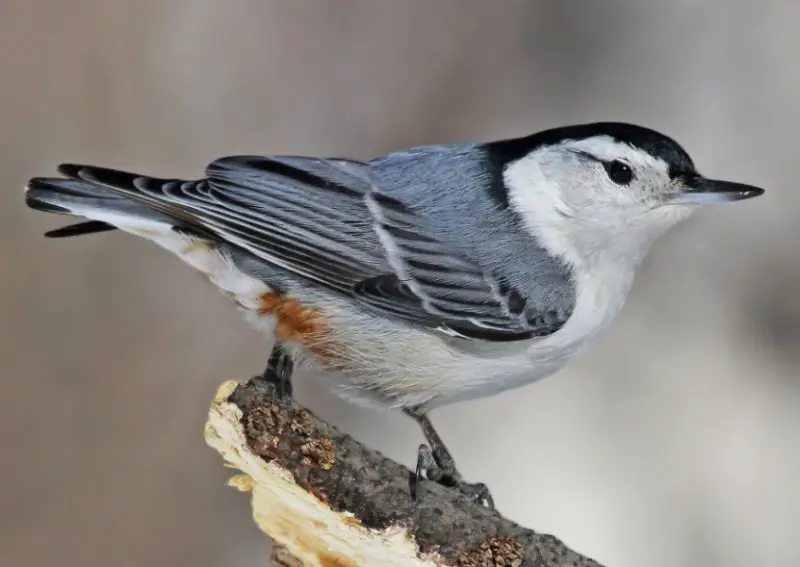
The White-breasted Nuthatch is a small, agile bird with a distinctive white face and breast contrasted against a slate-gray back and wings. Adults measure about 5 to 6 inches in length with a wingspan of 8 to 10 inches. Their short tail and strong, pointed bill help them expertly climb tree trunks and branches headfirst as they search for insects and seeds.
Their call is a nasal, rapid “yank-yank” sound, and they also produce a series of clear whistles. White-breasted Nuthatches are known for their unique behavior of creeping downward along tree bark, often wedging nuts or seeds into bark crevices and hammering them open with their bills. They are highly vocal and interact often with their mates and offspring.
Throughout Missouri, these nuthatches are year-round residents found mainly in mature deciduous forests, woodlots, and suburban parks with large trees. Their reliance on tree cavities or nest boxes for breeding makes them a familiar presence in wooded areas. Their distinctive foraging style and persistent calls make them easy to recognize in the Missouri bird community.
Tufted Titmouse
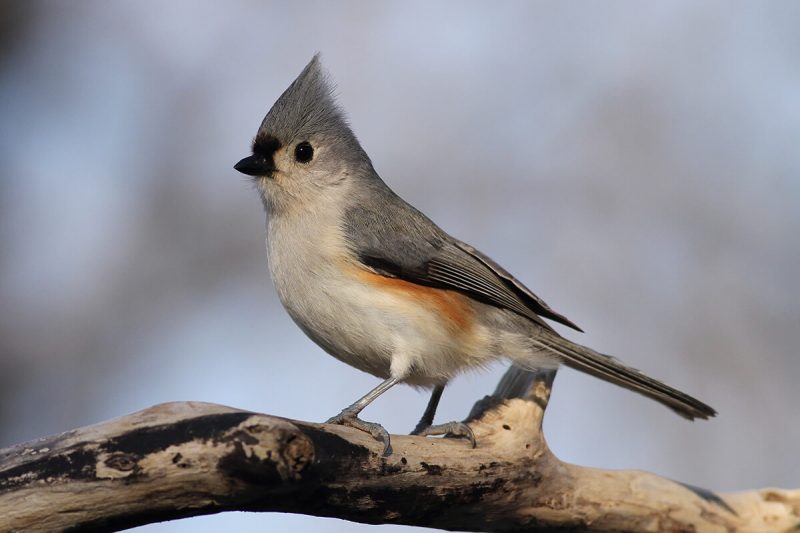
The Tufted Titmouse is a small, stocky songbird measuring about 5.5 to 6.3 inches in length with a wingspan of roughly 8 to 10 inches. It is easily identified by its gray upperparts, white underparts, and a distinctive tufted crest on its head. The bird’s large black eyes and short, stout bill give it a curious expression. In Missouri, Tufted Titmice are common in deciduous and mixed woodlands as well as suburban yards with mature trees.
Its vocalizations include a clear, whistled “peter-peter-peter” song as well as a variety of chips and trills used for communication within family groups. Tufted Titmice are active and inquisitive, often seen hopping through tree branches or visiting feeders where they eat seeds, nuts, insects, and berries. They cache food in bark crevices to retrieve later, demonstrating notable memory skills.
In Missouri, Tufted Titmice are year-round residents inhabiting forests, parks, and residential areas. They nest in tree cavities or nest boxes, often lining their nests with soft materials such as moss or feathers. Their bold behavior and distinctive crest make them a favorite among birdwatchers throughout the state.
Northern Mockingbird
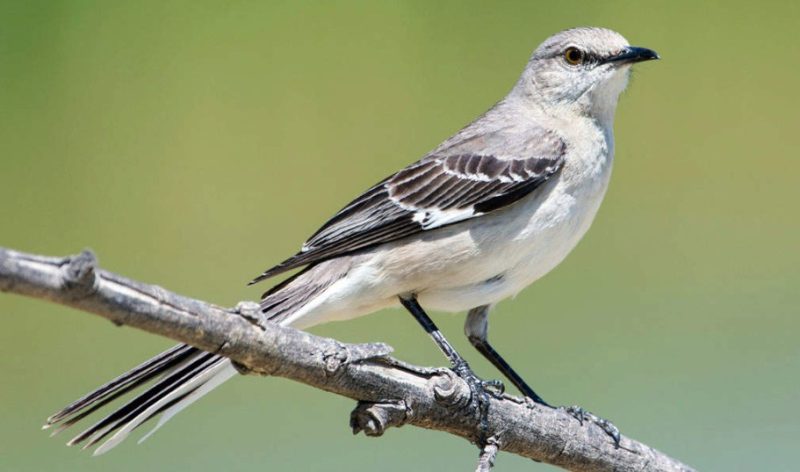
The Northern Mockingbird is a medium-sized songbird measuring approximately 8 to 10 inches in length with a wingspan of 12 to 15 inches. It has a slender body, gray upperparts, and pale underparts with white patches on the wings that are visible during flight. Its long tail and strong legs assist in its agile movements across open fields and shrublands typical of Missouri.
Renowned for its remarkable vocal ability, the Northern Mockingbird can imitate the songs of other birds, insects, and even mechanical noises. Its song is a complex series of varied phrases repeated several times before changing. Mockingbirds are territorial and often sing loudly both day and night, especially during the breeding season, to defend their area.
Northern Mockingbirds are common year-round in Missouri, favoring open habitats with scattered shrubs and trees, such as suburban yards, farmland edges, and parks. They build bulky nests in dense shrubs or low trees and are known for their aggressive defense of nests against intruders. Their impressive vocal range and bold nature make them a standout species in the Missouri bird community.
Common Grackle
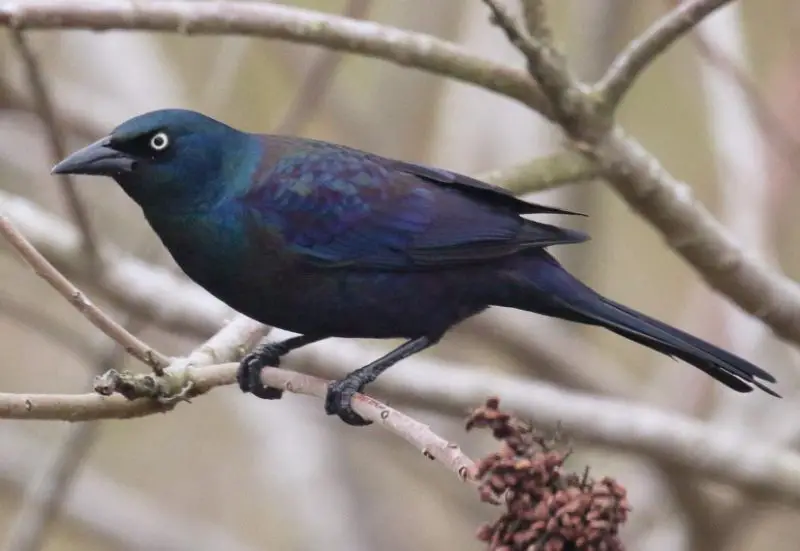
The Common Grackle is a large, glossy blackbird measuring about 11 to 13 inches in length with a wingspan of 16 to 18 inches. Its iridescent feathers can show hues of blue, green, and purple depending on the light. The grackle’s long tail is often keel-shaped and its yellow eyes contrast sharply with its dark plumage. In Missouri, Common Grackles are frequently seen in flocks around fields, parking lots, and urban areas.
Their vocalizations include a variety of harsh, squeaky calls, often described as a “glunk” or “chuck.” Grackles are opportunistic feeders, consuming insects, grains, fruits, and human food scraps. They forage on the ground and in shallow water, sometimes disturbing other birds or animals to steal food.
Common Grackles are widespread residents and migrants in Missouri, often gathering in large, noisy flocks during fall and winter. They nest in trees, shrubs, or man-made structures and can be quite aggressive toward other birds. Their striking iridescence and bold behavior make them a highly visible presence in Missouri’s mixed habitats.
Eastern Phoebe
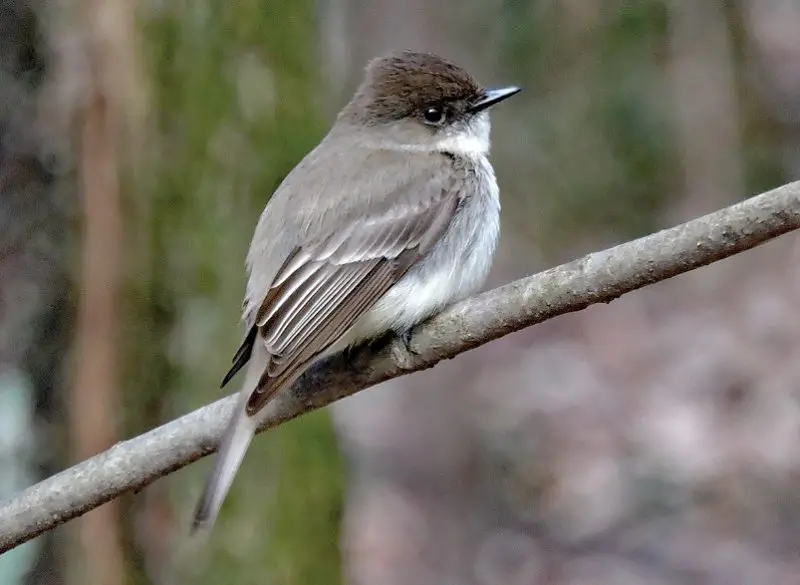
The Eastern Phoebe is a small flycatcher approximately 5.5 to 6.7 inches long with a wingspan of 10 to 11 inches. It has a plain gray-brown back, pale underparts, and a slightly darker head. Unlike many flycatchers, it lacks bright coloration, but its habit of wagging its tail up and down makes it easily identifiable in the field. In Missouri, it is commonly seen near water and open woodlands.
Its call is a sharp, two-note “fee-bee” or “phoebe” song, repeated often especially during the breeding season. Eastern Phoebes hunt insects by sallying from perches and catching prey midair or gleaning from foliage. They are one of the first flycatchers to return to Missouri in early spring and often build nests on human structures such as bridges, eaves, or barns.
Throughout Missouri, Eastern Phoebes prefer open habitats with nearby water sources like streams and ponds. They are abundant during breeding season but migrate southward in winter. Their modest appearance combined with their distinctive tail movements makes them a charming yet understated member of Missouri’s birdlife.
Killdeer
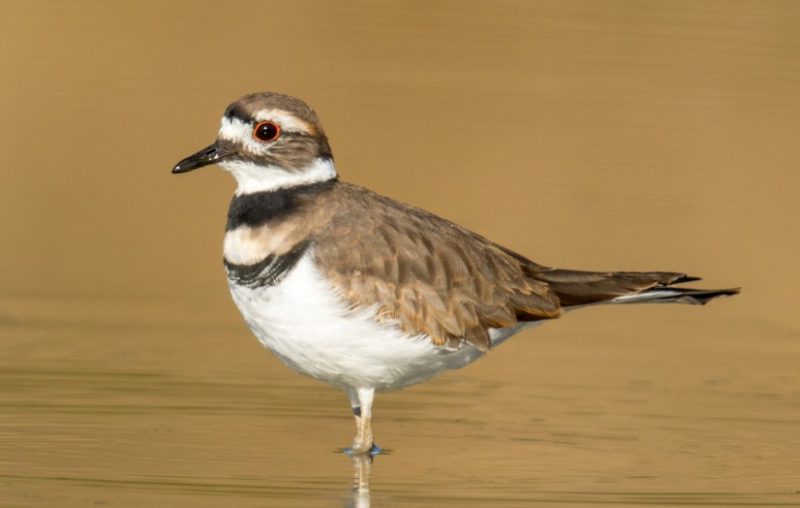
The Killdeer is a medium-sized shorebird measuring about 8 to 11 inches in length with a wingspan of 18 to 24 inches. It has distinctive brown upperparts, white underparts, and two bold black bands across the breast. Its long legs and large eyes help it navigate open ground and fields where it commonly forages. In Missouri, Killdeer are frequently seen in open habitats such as mudflats, grassy fields, and parking lots.
Known for its loud, high-pitched “kill-deer” call, this bird is also famous for its “broken-wing” distraction display used to lure predators away from its nest. Killdeer primarily feed on insects, worms, and other invertebrates by probing the soil with their slender bills. They are ground nesters, often placing their nests in gravelly or bare patches of land.
In Missouri, Killdeer are common spring and summer residents that may be seen throughout the state in a variety of open habitats, including agricultural areas and suburban lawns. Their adaptability to disturbed habitats and their conspicuous behaviors make them easily noticed by observers. Their unique markings and dramatic calls add diversity to Missouri’s bird fauna.
Cedar Waxwing
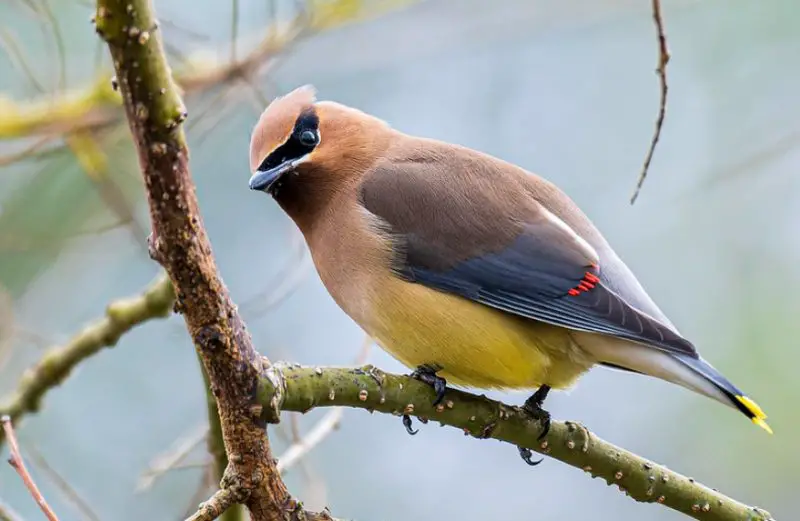
The Cedar Waxwing is a sleek, medium-sized songbird measuring about 6 to 7 inches in length with a wingspan of 8.7 to 11 inches. It has a smooth, silky plumage with pale brown on the head and chest, fading into soft gray on the wings and belly. Distinctive features include a crest on its head, a black mask around the eyes, and bright yellow tips on the tail feathers. In Missouri, Cedar Waxwings are often seen in flocks, especially near fruiting trees and shrubs.
Their high-pitched, thin trilling calls sound like a soft “seee” or “bzeee,” which they use to maintain contact in flocks. Cedar Waxwings feed primarily on fruits and berries, but they also catch insects in flight during warmer months. They are agile fliers, often seen swooping through the air or perched quietly while feeding.
In Missouri, Cedar Waxwings are common spring and summer visitors that may stay year-round in some areas with abundant food. They prefer open woodlands, orchards, and suburban areas with fruiting plants. Their fondness for berries and social behavior make them a charming sight during berry season.
Belted Kingfisher

The Belted Kingfisher is a medium-sized bird measuring about 11 to 14 inches long with a wingspan of 19 to 23 inches. It has a large head topped with a shaggy crest and a thick, pointed bill suited for catching fish. The bird’s plumage is slate blue on the upperparts with a white collar and underparts. Females are notable for having a rusty-colored band across the chest, in addition to the blue belt seen in both sexes. In Missouri, Belted Kingfishers are usually found near rivers, lakes, and ponds.
Their loud, rattling call is a distinctive “kik-kik-kik” often heard near water. These birds hunt by hovering briefly before diving headfirst to catch fish with their sharp bill. Belted Kingfishers perch prominently on branches or wires near water, scanning for prey below the surface.
Throughout Missouri, Belted Kingfishers breed near clean freshwater bodies and remain throughout much of the year, migrating only from the coldest northern parts of the state. Their reliance on aquatic habitats makes them important indicators of water quality. Their striking appearance and energetic fishing dives attract birdwatchers to Missouri’s waterways.
Wild Turkey
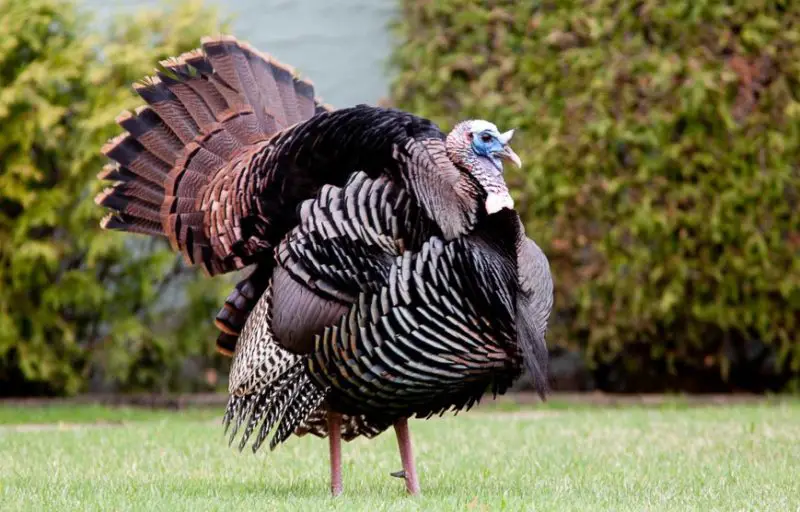
The Wild Turkey is a large, robust bird measuring about 36 to 45 inches in length with a wingspan of 49 to 66 inches. Males, known as toms, are larger and more colorful, with iridescent bronze and green feathers, a bare red head, and a prominent fan-shaped tail. Females, called hens, are smaller and duller in coloration. Wild Turkeys are ground-dwelling birds found throughout Missouri’s forests and fields.
Wild Turkeys communicate with a variety of sounds including gobbles, clucks, purrs, and yelps. The male’s gobble is a loud, rapid vocalization used to attract females and assert dominance. These birds forage mainly on the ground, eating nuts, seeds, insects, and small reptiles. They are known for their strong social structure and seasonal mating displays.
Wild Turkeys are widespread across Missouri and are often found in mixed hardwood forests, agricultural fields, and clearings. Their populations have rebounded due to successful conservation efforts, and they are now a common and celebrated game bird. Observing their dramatic courtship displays and hearing their distinctive gobbles is a memorable experience for many Missourians.
Red-winged Blackbird
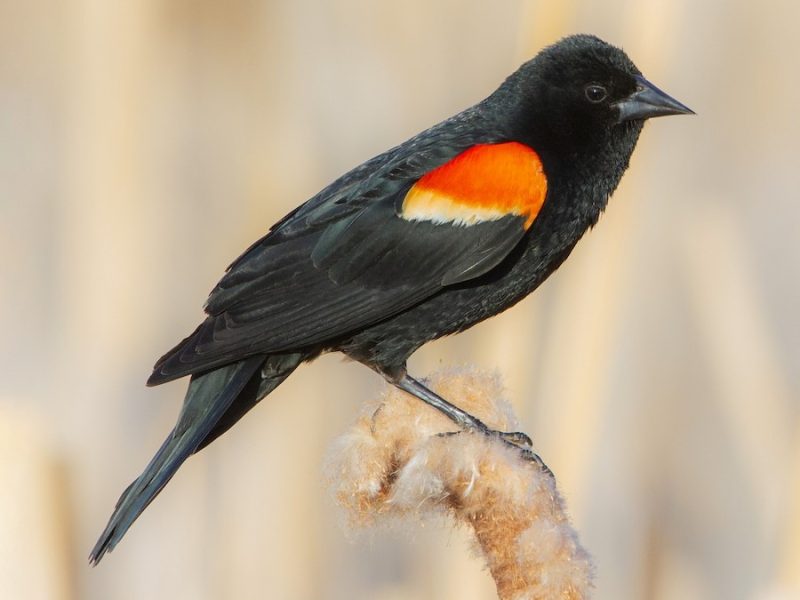
The Red-winged Blackbird is a medium-sized songbird measuring about 7 to 9 inches long with a wingspan of 12 to 16 inches. Males are glossy black with bright red and yellow shoulder patches called epaulets, while females are streaked brown and heavily camouflaged. These blackbirds are highly territorial, especially during the breeding season, and are one of the most abundant and vocal species in Missouri.
Their loud, distinctive song is a harsh, buzzing “conk-la-ree!” used to defend territory and attract mates. Red-winged Blackbirds primarily feed on seeds, insects, and grains. They are often seen perched on cattails or fence posts in marshes, wetlands, and agricultural fields, scanning for food or rivals.
In Missouri, Red-winged Blackbirds are common year-round residents, thriving in wetland habitats, flooded fields, and roadside ditches. Large flocks may gather outside the breeding season, creating noisy, swirling masses. Their striking colors and boisterous calls are emblematic of Missouri’s spring and summer wetlands.
Barn Swallow
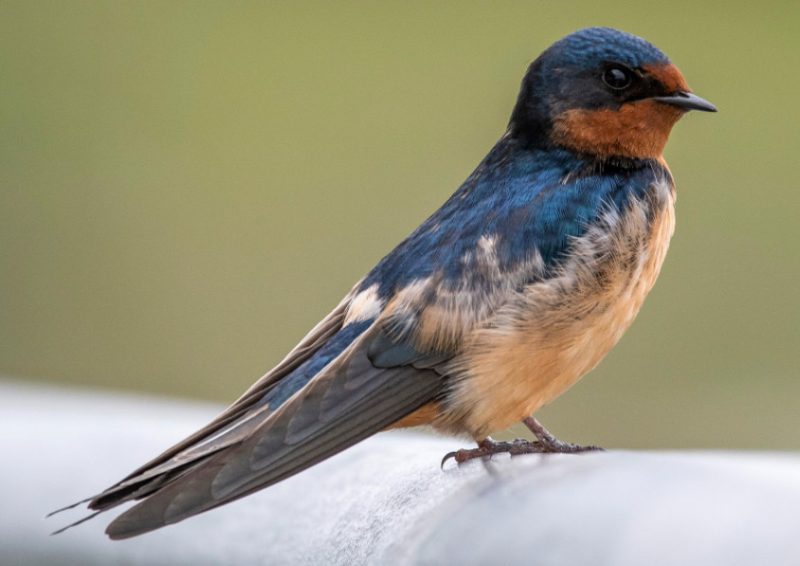
The Barn Swallow is a slender, agile bird about 7 to 8 inches in length with a wingspan of 12 to 14 inches. It is easily identified by its iridescent blue upperparts, rusty throat and forehead, and long, deeply forked tail. Barn Swallows are aerial insectivores known for their graceful, acrobatic flight. In Missouri, they are commonly seen soaring over fields, water, and open spaces.
Their song is a series of cheerful, twittering notes combined with a variety of chirps and warbles used during flight and social interaction. Barn Swallows catch insects on the wing, often flying low over water or fields to snatch prey midair. They build cup-shaped mud nests attached to buildings, bridges, and other man-made structures.
Barn Swallows breed across Missouri during the warmer months and migrate south for the winter. They prefer open habitats near water where insects are abundant and human structures for nesting. Their swift flight and joyous calls make them a beloved symbol of summer in Missouri’s rural and suburban landscapes.
Tree Swallow
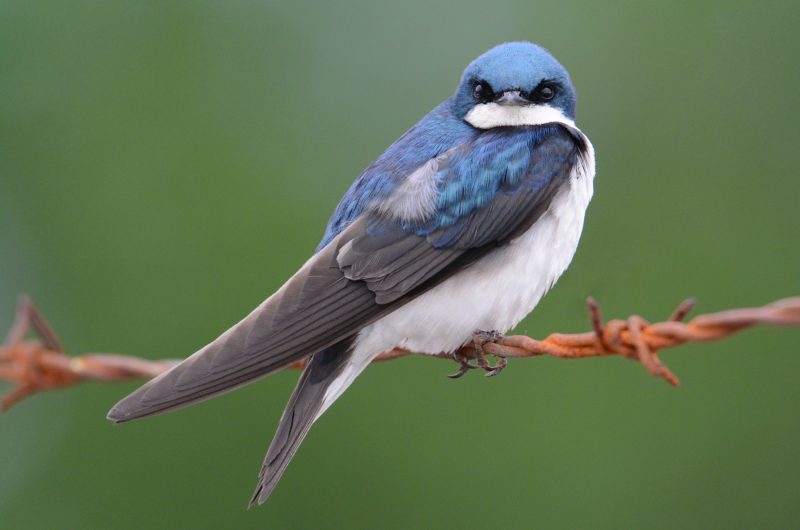
The Tree Swallow is a small, sleek bird measuring about 5 to 6 inches in length with a wingspan of 11 to 13 inches. It has iridescent blue-green upperparts and bright white underparts, giving it a clean and striking appearance. The slightly forked tail and streamlined body help it maneuver skillfully through the air. In Missouri, Tree Swallows are often seen near ponds, lakes, and wetlands during the breeding season.
Their vocalizations include soft, bubbly chatters and musical warbles used for communication within flocks. Tree Swallows feed primarily on flying insects, catching them in midair with impressive agility. They nest in tree cavities or nest boxes and are known to compete aggressively with other cavity-nesting birds for prime sites.
Throughout Missouri, Tree Swallows are common spring and summer residents that migrate southward during colder months. They prefer open habitats near water, where insect prey is abundant. Their striking metallic plumage and graceful flight make them a favorite among birdwatchers.
Brown-headed Cowbird
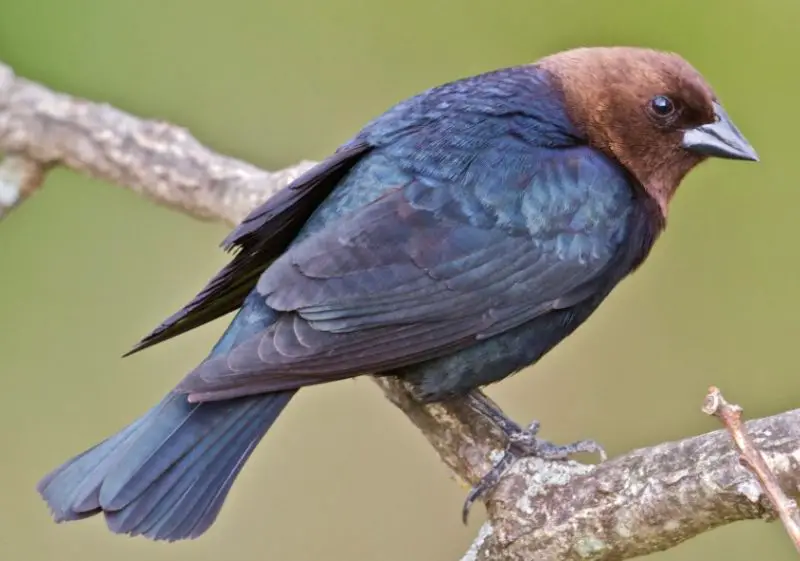
The Brown-headed Cowbird is a medium-sized blackbird measuring about 7.5 to 9.1 inches long with a wingspan of 12 to 16 inches. Males have glossy black bodies with a distinctive brown head, while females are duller brown overall. These birds have stout bodies and short tails, well adapted for foraging on the ground. In Missouri, Brown-headed Cowbirds are widespread across agricultural fields and open woodlands.
Their calls include harsh, nasal whistles and chatter, often described as a “glurrr” or “check.” Cowbirds are brood parasites, meaning females lay their eggs in the nests of other bird species, leaving the foster parents to raise their young. They feed mainly on seeds and insects, frequently following livestock to catch insects stirred up by grazing.
Brown-headed Cowbirds are common year-round residents in Missouri and have expanded their range thanks to human-altered landscapes. Their parasitic breeding strategy can negatively affect populations of some songbirds, making their presence controversial among conservationists. Despite this, their bold behavior and adaptability make them a noticeable part of Missouri’s bird community.
Eastern Towhee
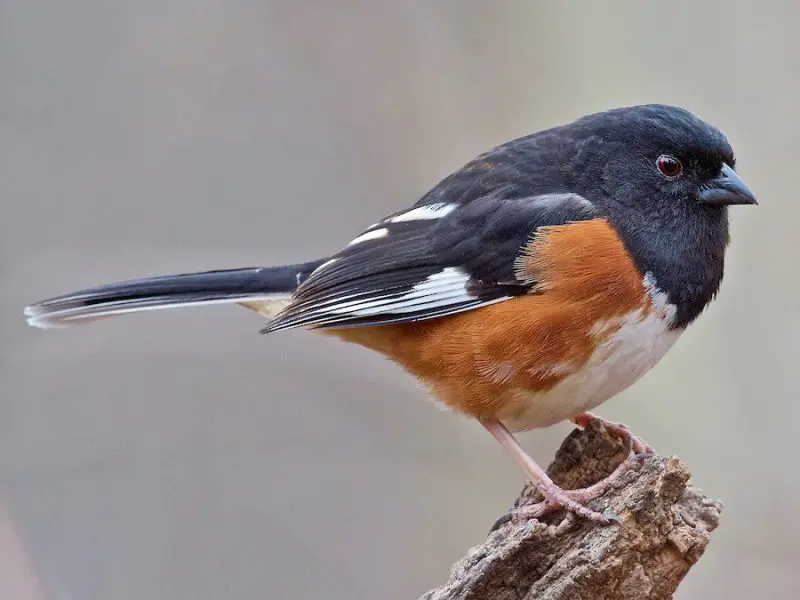
The Eastern Towhee is a striking sparrow-like bird measuring about 7 to 8.7 inches in length with a wingspan of 10 to 12 inches. Males have bold black upperparts, head, and throat, with bright rusty sides and white belly, while females replace black with warm brown. Their strong, conical bill and long tail aid in their ground foraging habits. In Missouri, Eastern Towhees prefer dense shrubby areas and forest edges.
Their song is a distinctive “drink-your-tea” phrase delivered in a clear, musical whistle. Towhees forage mostly on the ground, scratching leaf litter vigorously to uncover insects, seeds, and berries. They are known for their secretive behavior, often heard before they are seen, and for flicking their long tails while hopping on the forest floor.
Eastern Towhees are common year-round residents throughout Missouri, frequenting brushy habitats, gardens, and woodland borders. They nest low in shrubs or dense vegetation. Their colorful plumage and melodic song add richness to Missouri’s understory birdlife.
Chipping Sparrow
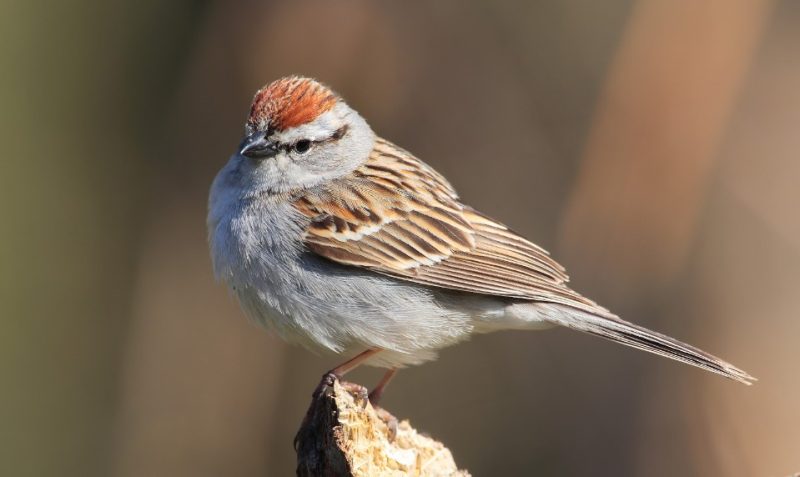
The Chipping Sparrow is a small, slender bird measuring about 4.7 to 5.5 inches in length with a wingspan of 7.9 to 9.1 inches. It has rusty-red crown feathers, a clear gray face, and a distinct black line through the eye. Its light breast and wings are streaked lightly with brown. In Missouri, Chipping Sparrows are commonly found in open woodlands, parks, and suburban yards.
Their song is a rapid, mechanical trill lasting several seconds, often heard during the breeding season as a territorial display. These sparrows forage mostly on the ground or low shrubs for seeds and insects. They are social birds during migration and winter but territorial while nesting.
Chipping Sparrows are abundant summer residents in Missouri, arriving in spring and departing by fall migration. They nest in trees or shrubs, often near human habitation. Their bright rusty crown and continuous trilling song make them an easily recognizable and welcome spring visitor.
Indigo Bunting
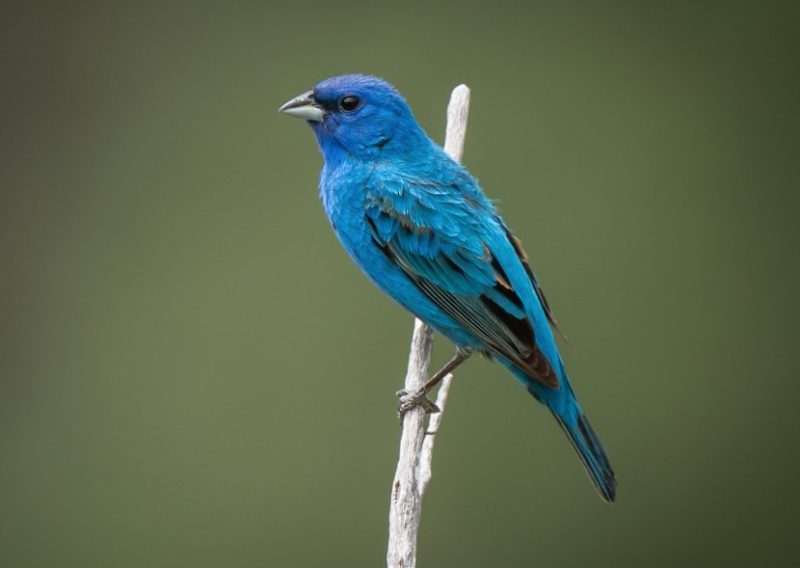
The Indigo Bunting is a small, vibrant songbird about 4.5 to 5 inches long with a wingspan of 7.5 to 9 inches. Males are covered in brilliant deep blue plumage all over, while females are brown with subtle hints of blue on the wings and tail. Their short, conical bill suits a diet of seeds and insects. In Missouri, Indigo Buntings frequent woodland edges, brushy fields, and roadsides.
Their song is a rich, high-pitched warble consisting of varied phrases repeated in sequences. Indigo Buntings sing from exposed perches during the breeding season to establish territories and attract mates. They feed primarily on seeds, berries, and insects, often gleaned from low vegetation.
In Missouri, Indigo Buntings are common summer residents, arriving in spring to breed and migrating south for winter. Their dazzling blue coloration and cheerful song brighten Missouri’s warm months and delight birdwatchers who eagerly seek their presence in suitable habitats.
American Crow
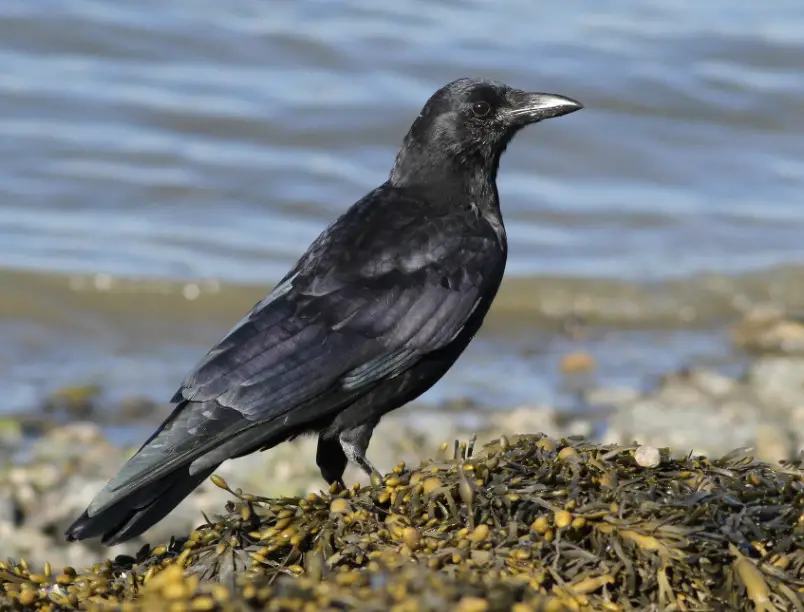
The American Crow is a large, all-black bird measuring about 16 to 21 inches in length with a wingspan of 33 to 39 inches. Its glossy black feathers, sturdy build, and strong, straight bill make it easily recognizable. Crows have a robust, direct flight and are often seen soaring or flying in loose flocks. In Missouri, American Crows are one of the most widespread and adaptable birds, thriving in urban, suburban, and rural environments.
Their call is a loud, harsh “caw” that serves various social functions such as alerting to danger or communicating within the flock. Highly intelligent and social, American Crows exhibit complex behaviors including tool use, problem-solving, and cooperative breeding. They feed on a wide range of foods, from insects and small animals to grains and human scraps.
American Crows are common year-round in Missouri and can be found in almost every habitat, including farmland, forests, and cities. Their adaptability and boldness around humans make them a familiar and important part of Missouri’s bird community, often seen gathering in large communal roosts during the winter months.
Great Horned Owl
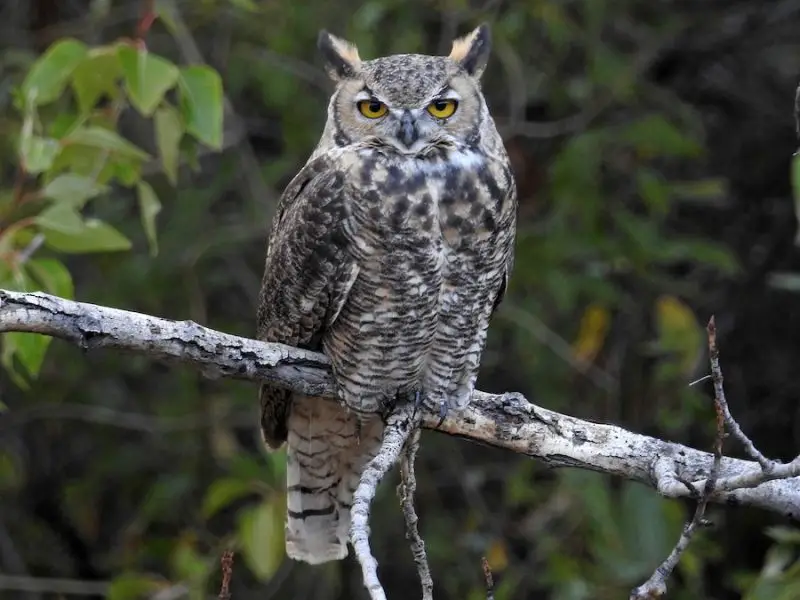
The Great Horned Owl is a large, powerful raptor measuring 18 to 25 inches in length with a wingspan of 3.3 to 4.8 feet. It is named for its prominent feather tufts resembling horns or ears. Its plumage is mottled gray-brown with a barred pattern and a white throat patch. This nocturnal predator has piercing yellow eyes and a strong hooked beak. In Missouri, Great Horned Owls inhabit diverse habitats including forests, swamps, and urban areas.
Their deep, booming hoot “hoo-hoo-hoo hoo hoo” is often heard at dusk and nighttime, serving to establish territory and attract mates. Great Horned Owls are formidable hunters, preying on mammals, birds, reptiles, and amphibians. They use their powerful talons and silent flight to capture prey with remarkable stealth.
These owls are year-round residents in Missouri, nesting in tree cavities, abandoned nests of other large birds, or cliff ledges. Their ability to adapt to various environments and wide-ranging diet makes them one of Missouri’s most successful and iconic raptors.
Barred Owl
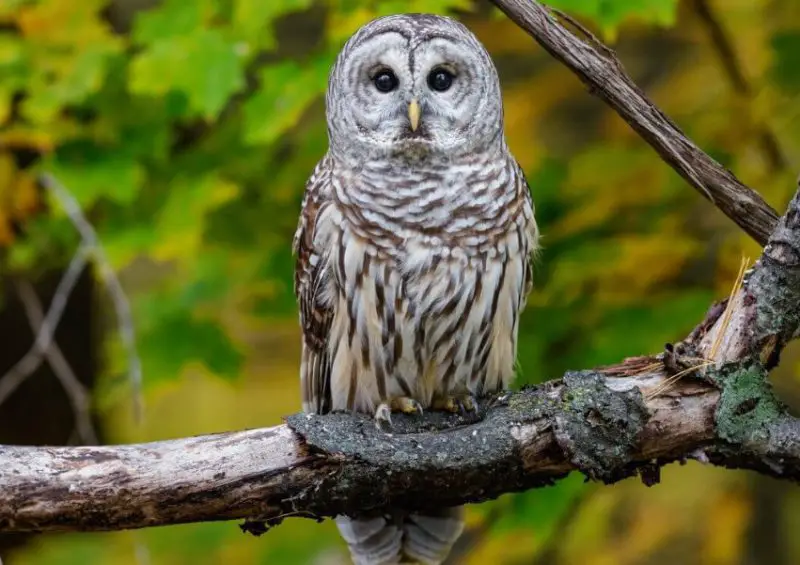
The Barred Owl is a large, stocky owl about 16 to 25 inches long with a wingspan of 38 to 49 inches. Its distinctive plumage features horizontal barring on the chest and vertical streaks on the belly, giving it its name. The owl has large dark eyes and lacks ear tufts, with a round face bordered by a pale facial disk. In Missouri, Barred Owls prefer mature forests and wooded swamps.
Their call is a series of hoots often described as “who cooks for you, who cooks for you all,” which carries clearly through the forest at night. Barred Owls hunt small mammals, birds, amphibians, and insects, primarily using their excellent night vision and hearing. They are often seen perched quietly during the day but become active after dusk.
Barred Owls are common year-round residents in Missouri’s mature woodlands and wetland areas. They nest in tree cavities or abandoned nests and are known for their strong territorial behavior. Their haunting calls and secretive nature make them a fascinating subject for Missouri birdwatchers.
Wood Duck
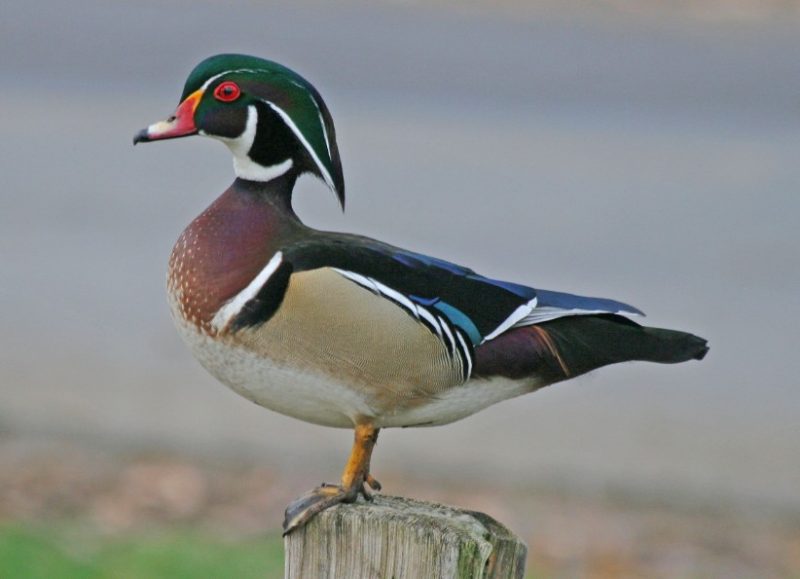
The Wood Duck is a medium-sized, colorful waterfowl measuring about 16 to 21 inches in length with a wingspan of 26 to 29 inches. Males are striking with iridescent green, purple, and chestnut plumage, a distinctive crest, and red eyes. Females are more subdued with gray-brown bodies and white eye rings. Wood Ducks are highly adapted for life in wooded swamps, rivers, and ponds across Missouri.
Their calls include high-pitched whistles and squeals, used for communication between mates and within broods. Wood Ducks feed on seeds, fruits, insects, and aquatic plants, often dabbling near the water’s surface. They are expert flyers, capable of quick takeoffs from water and maneuvering through dense vegetation.
In Missouri, Wood Ducks breed in wooded wetlands and nest in tree cavities or nest boxes. They are one of the most colorful and charismatic waterfowl species in the state, and their populations have benefited from conservation and habitat restoration efforts.
Northern Flicker
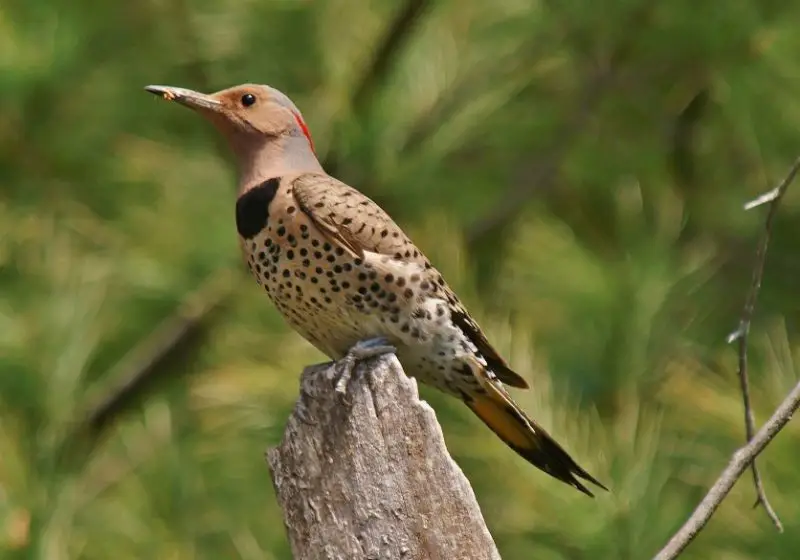
The Northern Flicker is a medium-sized woodpecker measuring about 11 to 12 inches in length with a wingspan of 16 to 20 inches. Unlike many woodpeckers, flickers have brownish bodies with black spots and bars, a white rump visible in flight, and a distinctive black crescent on the chest. Males typically have a red or black “mustache” stripe on the face. In Missouri, Northern Flickers are common in woodlands, parks, and suburban areas.
Their call is a loud, ringing “wick-a-wick-a-wick” accompanied by a rapid drumming on trees or metal surfaces. Flickers forage mostly on the ground, feeding on ants and other insects by probing the soil with their long tongue. They also eat fruits and seeds and will excavate nest cavities in dead trees or utility poles.
Northern Flickers are widespread year-round residents in Missouri and adapt well to a variety of habitats. Their distinctive plumage, vocalizations, and behavior make them one of the most easily recognized and studied woodpeckers in the region.
Hairy Woodpecker
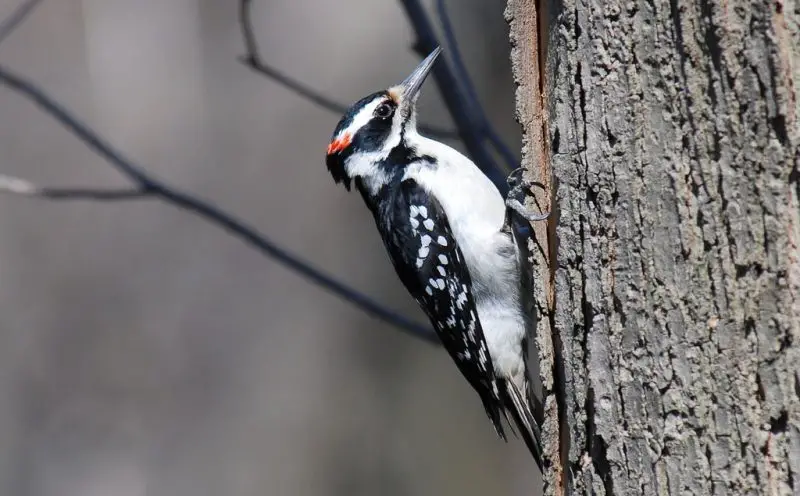
The Hairy Woodpecker is a medium-sized woodpecker measuring about 9 to 10 inches in length with a wingspan of 15 to 19 inches. It has a black-and-white patterned plumage with a predominantly white underside, black wings with white spots, and a bold white stripe down its back. Males feature a small red patch on the back of the head. Its long, straight bill is strong and slightly thicker than that of the similar Downy Woodpecker. In Missouri, Hairy Woodpeckers are found in mature forests and wooded suburban areas.
Their call is a sharp “peek” or “quank” sound, accompanied by rapid drumming on tree trunks to communicate or defend territory. Hairy Woodpeckers forage by hammering into tree bark to extract insects, especially wood-boring larvae, but also eat seeds and berries. They are adept climbers and can cling vertically to trees with ease.
In Missouri, Hairy Woodpeckers are year-round residents, preferring mixed hardwood and coniferous forests. They nest in tree cavities they excavate themselves and often return to the same territory each year. Their striking black-and-white appearance and active foraging behavior make them a noticeable presence in Missouri’s woodlands.
Pileated Woodpecker
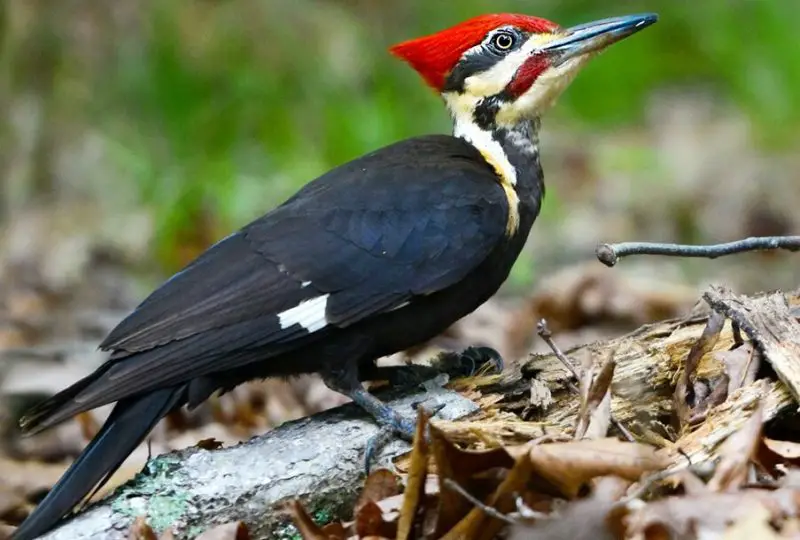
The Pileated Woodpecker is one of the largest woodpeckers in North America, measuring about 16 to 19 inches long with a wingspan of 26 to 30 inches. It is unmistakable with its bold black body, white stripes down the neck, and a vivid red crest on the head. Its powerful, chisel-like bill is designed for excavating large cavities in dead or decaying trees. In Missouri, Pileated Woodpeckers prefer mature forests with plenty of standing dead wood.
Their call is a loud, ringing “kuk-kuk-kuk” and a distinctive drumming that resonates through the forest. Pileated Woodpeckers excavate large rectangular holes in trees to find carpenter ants and wood-boring beetle larvae, their primary food sources. These birds are often seen flying with slow, deliberate wing beats and a strong, undulating flight pattern.
Pileated Woodpeckers are year-round residents in Missouri and are indicators of healthy forest ecosystems. They nest in large tree cavities and sometimes reuse old nests. Their impressive size, striking red crest, and loud calls make them one of Missouri’s most iconic woodland birds.
Blue-gray Gnatcatcher
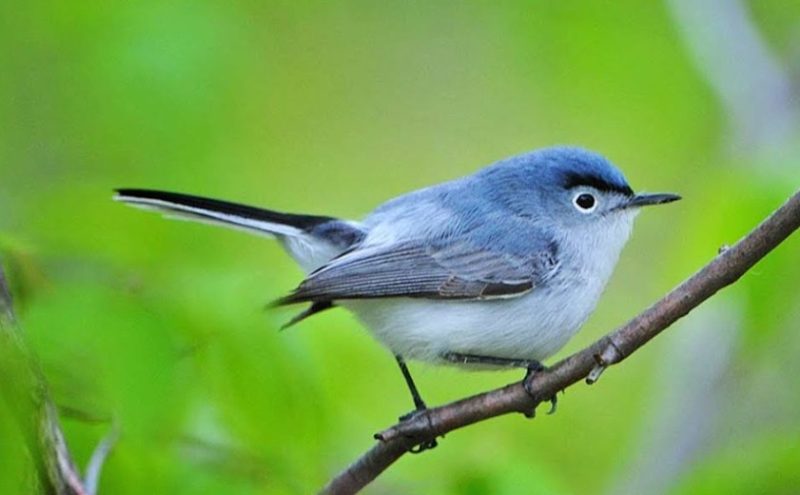
The Blue-gray Gnatcatcher is a tiny songbird, about 4 to 5 inches long with a wingspan of 6 to 8 inches. It has soft blue-gray upperparts, white underparts, and a long tail edged with white. Its thin, pointed bill is perfect for catching small insects. In Missouri, Blue-gray Gnatcatchers are active and agile, flitting through foliage in deciduous woodlands, parks, and gardens.
Its song is a high-pitched, buzzy trill often heard during the breeding season. Blue-gray Gnatcatchers feed primarily on small insects and spiders, gleaning them from leaves and branches. They are energetic and constantly on the move, frequently flicking their tails and wings.
In Missouri, Blue-gray Gnatcatchers are summer residents, arriving in spring and departing by fall migration. They nest in small cups often built on horizontal tree branches using spider silk, lichens, and plant fibers. Their tiny size, soft coloration, and lively behavior make them a delightful sight in Missouri’s woodlands.
White-throated Sparrow
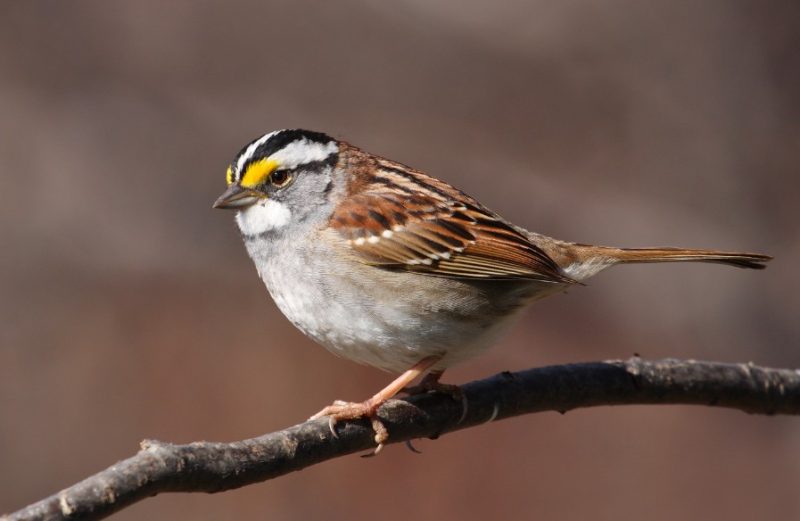
The White-throated Sparrow is a medium-sized songbird measuring about 6 to 7 inches in length with a wingspan of 8.7 to 11 inches. It is recognizable by its gray face, white throat patch, and striking yellow “lores” (spots between the eyes and bill). The crown features black and white or tan and brown stripes depending on the morph. In Missouri, White-throated Sparrows are primarily migrants and winter visitors.
Their clear, whistled song sounds like “Old Sam Peabody, Peabody, Peabody,” often heard in forest edges and shrubby areas. These sparrows feed on seeds and insects on the ground, scratching through leaf litter for food. They are shy and often remain hidden while foraging, but their songs make them easy to detect.
In Missouri, White-throated Sparrows are most commonly seen during migration and winter, frequenting wooded and brushy habitats. Their beautiful song and distinctive facial markings make them a favorite for birders during the colder months.
Yellow-billed Cuckoo
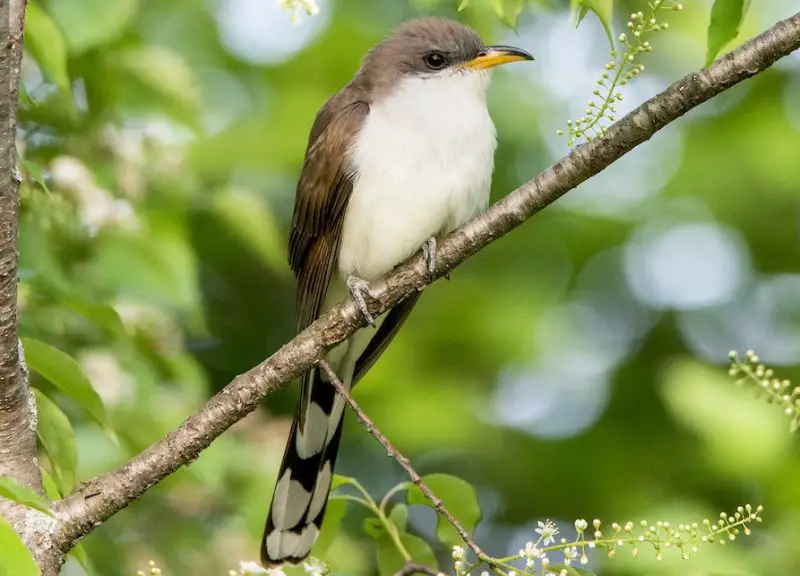
The Yellow-billed Cuckoo is a medium-sized bird about 11 to 13 inches long with a wingspan of 14 to 16 inches. It has a slender body, brownish upperparts, and white underparts with a slightly curved yellow bill. Its long tail has white spots visible in flight. In Missouri, Yellow-billed Cuckoos prefer dense woodlands and riparian areas during the breeding season.
Their call is a slow, hollow, repetitive “ku-kuu-ku” or “cuck-owl” sound, often heard at dusk or nighttime. Yellow-billed Cuckoos are insectivores specializing in caterpillars, including hairy and toxic species that many birds avoid. They forage by creeping slowly through foliage or sallying out to catch insects in flight.
In Missouri, Yellow-billed Cuckoos are summer residents, migrating south in the fall. Their preference for dense shrubbery and their elusive behavior make them a somewhat secretive but fascinating species to observe. Their unique calls and specialized diet contribute to the diversity of Missouri’s woodland bird community.
Eastern Kingbird
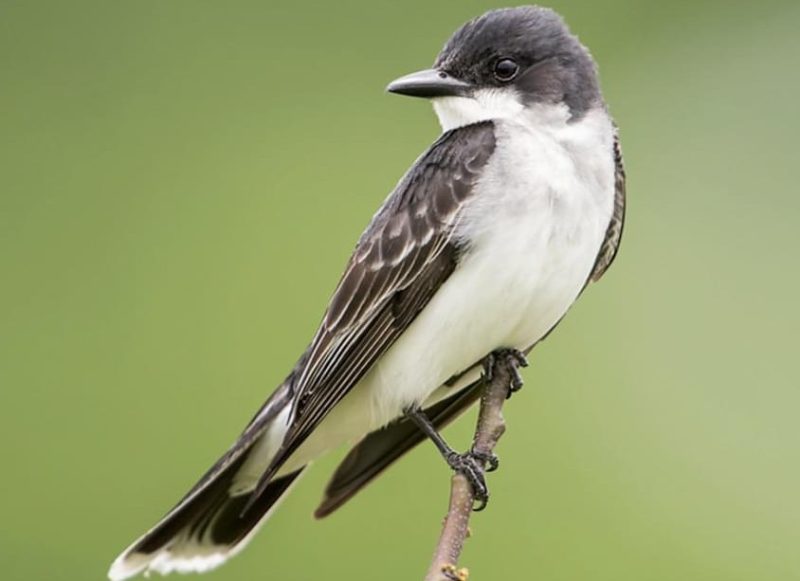
The Eastern Kingbird is a medium-sized flycatcher measuring about 7.5 to 9 inches in length with a wingspan of 13 to 16 inches. It has a distinctive black head and back, white underparts, and a broad white band at the tip of its tail. This bird’s bold, contrasting plumage makes it easy to identify. In Missouri, Eastern Kingbirds are commonly found in open habitats such as fields, wetlands, and along forest edges.
Their vocalizations consist of sharp, high-pitched “kip” or “kip-kip” calls and a variety of chattering sounds. Eastern Kingbirds are aggressive defenders of their territories and will fiercely chase away intruders, including much larger birds. They catch flying insects on the wing with impressive agility, often hovering briefly before darting out to seize prey.
Throughout Missouri, Eastern Kingbirds are summer residents that migrate south for the winter. They build cup-shaped nests in shrubs or trees and prefer open areas near water. Their bold behavior and striking plumage make them a charismatic presence in Missouri’s summer skies.
Prairie Warbler
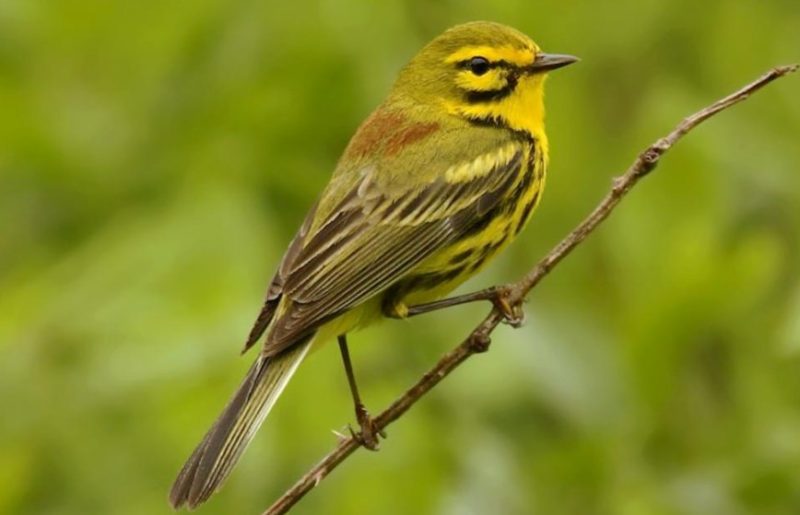
The Prairie Warbler is a small, active songbird measuring about 4.3 to 5.1 inches in length with a wingspan of 6.3 to 7.1 inches. It has bright yellow underparts streaked with black, olive-green upperparts, and distinctive black streaks on its sides. Males display brighter coloration than females. In Missouri, Prairie Warblers are often found in shrubby fields, open woodlands, and early successional habitats.
Their song is a buzzy, accelerating series of phrases that sound like “weazy-weazy-weazy,” repeated rapidly. Prairie Warblers forage actively in low shrubs and trees, gleaning insects and spiders from foliage. They are often seen flicking their wings and tail as they move through brushy areas.
In Missouri, Prairie Warblers are primarily breeding residents in suitable habitats during the warmer months. Their preference for shrubby and regenerating forests makes them an indicator species for healthy early successional landscapes. Their bright yellow color and lively song add vibrancy to Missouri’s bird community.
Red-headed Woodpecker
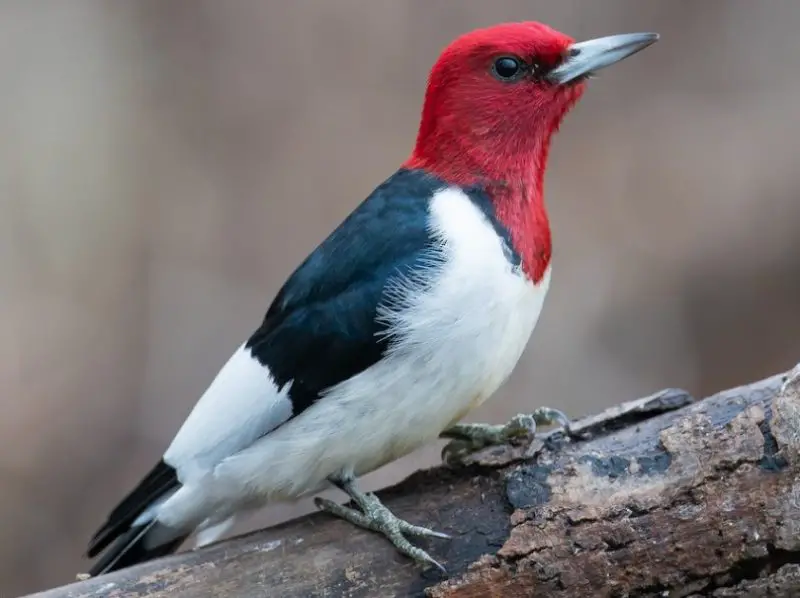
The Red-headed Woodpecker is a striking bird about 8.3 to 9.8 inches long with a wingspan of 16 to 18 inches. Its most notable feature is the entirely bright red head, contrasted with a white body and bold black wings with white patches. This woodpecker has a strong, chisel-shaped bill and a robust body built for foraging and excavating. In Missouri, Red-headed Woodpeckers favor open woodlands, forest edges, and areas with dead trees.
Their call is a loud, harsh “chak” or “kek” repeated rapidly, often accompanied by drumming on hollow trees. Red-headed Woodpeckers are omnivorous, feeding on insects, nuts, fruits, and even small vertebrates. They are known for their habit of caching food in tree crevices for later consumption.
Red-headed Woodpeckers are year-round residents in Missouri but may be more numerous in summer. They nest in tree cavities, often excavating their own or using abandoned holes. Their brilliant coloration and dynamic behavior make them a favorite for bird enthusiasts in Missouri’s woodlands.
Purple Martin
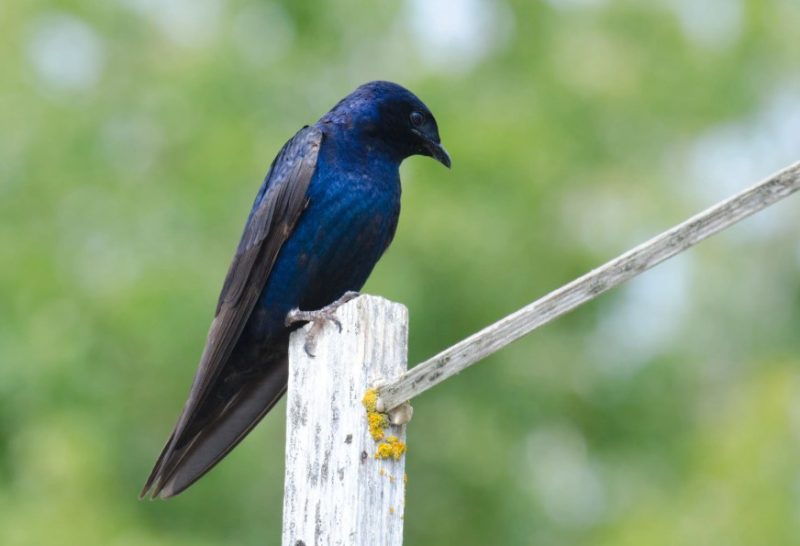
The Purple Martin is the largest swallow in North America, measuring about 7.5 to 8.7 inches in length with a wingspan of 12.6 to 16 inches. Adult males are glossy iridescent blue-purple all over, while females and juveniles are duller with grayish underparts. Their streamlined bodies and long, pointed wings enable swift and graceful flight. In Missouri, Purple Martins are colonial nesters often found near water and human habitations.
Their calls include soft chirps, gurgles, and twittering sounds exchanged during flight and at nesting sites. Purple Martins feed exclusively on flying insects, catching them in aerial acrobatics with remarkable speed and precision. They nest in man-made birdhouses or gourds provided by humans, showing strong site fidelity.
Purple Martins arrive in Missouri in spring and stay through summer to breed, migrating south for the winter. Their reliance on human-provided nesting sites has led to close relationships with people, making them a popular species for conservation efforts and backyard birdwatching.


